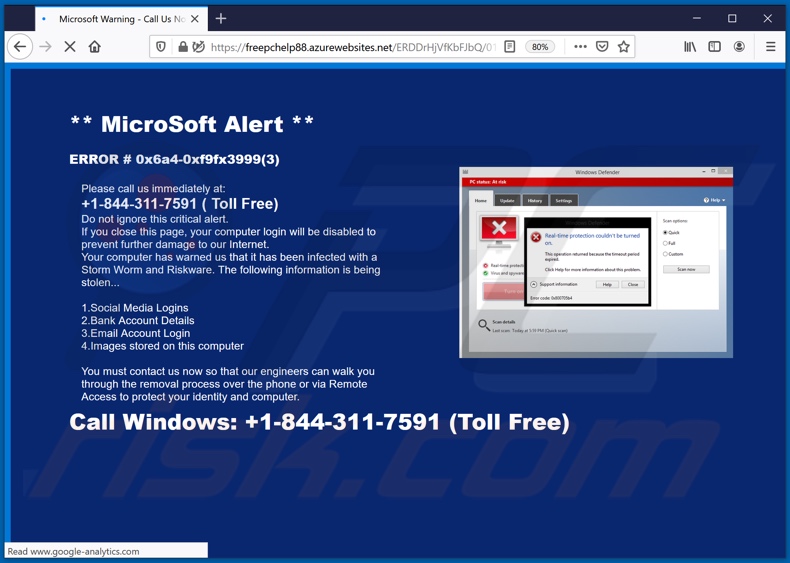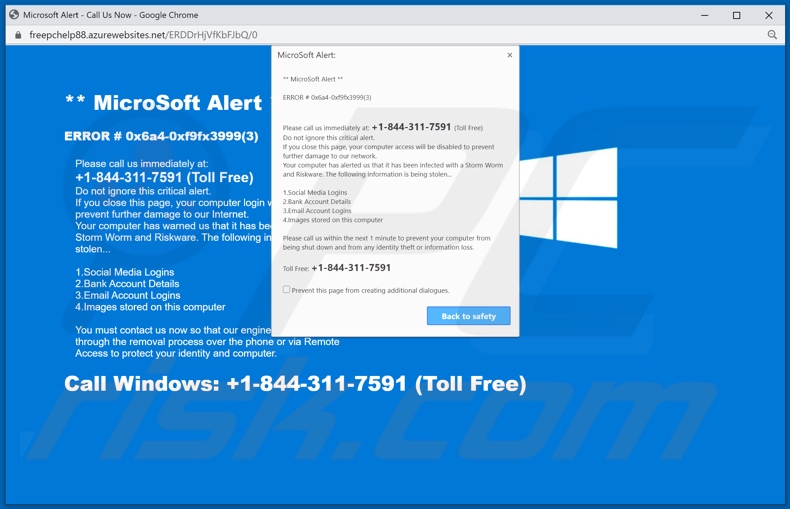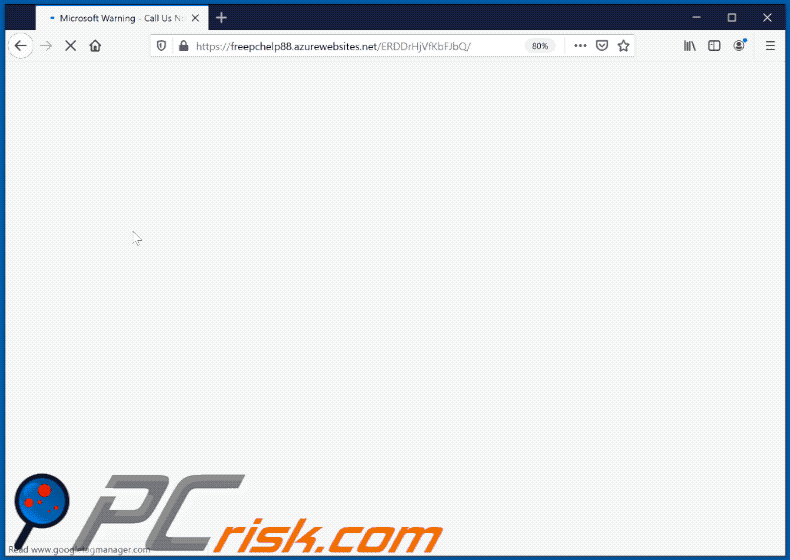Avoid being scammed by websites displaying "ERROR # 0x6a4-0xf9fx3999"
Phishing/ScamAlso Known As: ERROR # 0x6a4-0xf9fx3999 tech support scam
Get free scan and check if your device is infected.
Remove it nowTo use full-featured product, you have to purchase a license for Combo Cleaner. Seven days free trial available. Combo Cleaner is owned and operated by RCS LT, the parent company of PCRisk.com.
What is the "ERROR # 0x6a4-0xf9fx3999" scam?
"ERROR # 0x6a4-0xf9fx3999" is a technical support scam run on various deceptive websites. This scheme has been observed being promoted via the Microsoft Azure website-hosting platform. At the time of research, there were two variants of the "ERROR # 0x6a4-0xf9fx3999" scam, which are practically identical in terms of displayed text.
The scheme is presented as an alert from Microsoft claiming that users' devices have been infected and, if the web page is closed, their computers will be blocked to prevent further damage. "ERROR # 0x6a4-0xf9fx3999" is a scam and is in no way associated with the Microsoft Corporation.
Typically, sites that promote these schemes are accessed through mistyped URLs, redirects caused by intrusive advertisements, or unwanted applications. These apps do not need express user permission to be installed onto systems and can have various harmful capabilities.

"ERROR # 0x6a4-0xf9fx3999" scam overview
When a web page promoting the "ERROR # 0x6a4-0xf9fx3999" scam is accessed, visitors are presented with a pop-up window. The message therein is disguised as an important alert from Microsoft. It urges users not to ignore the warning and to call the provided toll-free number.
Visitors are warned that if this page is closed, their devices will supposedly be blocked to prevent further damage. The computers are allegedly infected with "Storm Worm and Riskware".
These (nonexistent) malware infections are apparently putting users' social media and email account log-ins credentials (i.e. IDs, usernames and passwords), banking account details, and stored images, at risk. The scheme urges users to call the "helpline" to receive instructions about how to eliminate the (fake) infections.
The text presented in the background page simply repeats what is stated in the pop-up. Scammers use this type of scheme in various ways.
They often attempt to gain access to victims' devices, which they can then infect with actual malware such as Remote Access Trojan (RATs) to ensure indefinite and stealthy access and control over devices, other types of Trojans, ransomware, cryptominers, and so on.
Cyber criminals also target private, sensitive data such as content stored on the device, communication (e.g. email, social networking/media, messenger, etc.) and financial (e.g. e-commerce, online money transfers, cryptocurrency, banking, etc.) accounts, names, addresses, credit card details, and so on.
Scammers can obtain this information by tricking victims into revealing it, extracting it from their computers and/or through phishing websites.
Furthermore, the "services" offered by scammers are usually extraordinarily expensive. In summary, trusting "ERROR # 0x6a4-0xf9fx3999" or similar scams can result in system infections, financial loss, serious privacy issues and even identity theft. Should it be impossible to close a deceptive site, use Windows Task Manager to end the browser process.
To prevent the website from being reopened, do not restore the previous browsing session.
More about unwanted apps promoting such scams
As mentioned, deceptive web pages can be accessed via redirects caused by rogue apps. As well as force-opening dubious and dangerous sites, this software can have additional capabilities. Adware-types deliver pop-ups, banners, coupons and other intrusive ads.
When clicked, the delivered ads redirect to harmful websites and some can even stealthily download/install rogue software (e.g. unwanted apps). Browser hijackers are other unwanted applications, which operate by making modifications to browser settings and restricting/denying access to them (to promote fake search engines).
Most of these apps monitor users' browsing activity. Information of interest includes browsing and search engine histories, IP addresses, geolocations and other details. Therefore, to ensure device and user safety, all suspicious applications and browser extensions/plug-ins must be removed without delay.
| Name | ERROR # 0x6a4-0xf9fx3999 tech support scam |
| Threat Type | Phishing, Scam, Social Engineering, Fraud. |
| Fake Claim | Scam claims users' devices are infected and may be blocked to prevent further damage. |
| Disguise | Microsoft |
| Tech Support Scammer Phone Number | +1-844-311-7591 |
| Symptoms | Fake error messages, fake system warnings, pop-up errors, hoax computer scan. |
| Distribution methods | Compromised websites, rogue online pop-up ads, potentially unwanted applications. |
| Damage | Loss of sensitive private information, monetary loss, identity theft, possible malware infections. |
| Malware Removal (Windows) |
To eliminate possible malware infections, scan your computer with legitimate antivirus software. Our security researchers recommend using Combo Cleaner. Download Combo CleanerTo use full-featured product, you have to purchase a license for Combo Cleaner. 7 days free trial available. Combo Cleaner is owned and operated by RCS LT, the parent company of PCRisk.com. |
Similar scams in general
"Activation Failed! (Error Code 001)", "Windows Error Code: DLL011150", "Error Code : EBRX1:6X76D", and "Covid19 Warning Alert" are some examples of other tech support scams. There are thousands of these schemes online using different techniques to lure victims.
Popular scam models include: warnings that the system is infected or at risk, alerts that a crucial piece of software is outdated or missing, fake prize giveaways, "unbelievable" offers, etc. Regardless of what the scams offer, claim, request or demand, their purpose is identical: to generate profit for the scammers/cyber criminals behind them.
How did unwanted applications install on my computer?
Browser hijackers, adware-type apps, and other types of unwanted applications are commonly distributed by integrating them into the download and/or installation set-ups of other programs, so that a proportion of users inadvertently download and install them together with their chosen software. This distribution method is known as "bundling".
Offers to download and install additionally-included apps usually appear in "Advanced", "Custom" and other settings of the set-ups (where they can usually be declined).
Many users fail to check and change these settings, thereby granting permission for dubious apps to be downloaded and installed by default. In addition, unwanted downloads and installations are sometimes caused by clicking deceptive advertisements capable of executing certain scripts.
How to avoid installation of unwanted applications
You are strongly advised to research all software before download/installation and/or purchase. All downloads must be done from official and verified sources, since untrusted channels including unofficial and free file-hosting websites, Peer-to-Peer sharing networks and other third party downloaders commonly offer bundled and harmful content.
When downloading/installing, you are advised to read the terms, explore all possible options, use the "Custom/Advanced" settings and opt-out of additional apps, tools, features, etc. It is also important to exercise caution when browsing.
Intrusive ads may seem legitimate, however, they can redirect to highly dubious web pages (e.g. gambling, pornography, adult-dating, and so on). If you encounter these advertisements or redirects, check the system and remove all suspect applications and browser extensions/plug-ins immediately removed.
If your computer is already infected with shady apps, we recommend running a scan with Combo Cleaner Antivirus for Windows to automatically eliminate them.
Text presented in the "ERROR # 0x6a4-0xf9fx3999" scam:
Pop-up:
** Microsoft Important Alert **
ERROR # 0x6a4-0xf9fx3999(3)
Call us immediately at: +1-844-311-7591 .
Don't ignore this alert..
If you close this page, your computer login will be disabled to prevent further damage to our Internet. Your computer has warned us that it has been infected with a Storm Worm and Riskware.
The following information is at risk:
1.Social Media Logins
2.Bank Account Details
3.Email Account Logins
4.Images stored on this computer.
You must contact us now so that our engineers can walk you through the removal process over the phone or via Remote Access to protect your identity and computer. Please call us within the next 1 minute to prevent your computer from being shut down and from any identity theft or information loss.
Toll Free:+1-844-311-7591
----------------
Background page:
** MicroSoft Alert **
ERROR # 0x6a4-0xf9fx3999(3)
Please call us immediately at:
+1-844-311-7591 ( Toll Free)
Do not ignore this critical alert.
If you close this page, your computer login will be disabled to prevent further damage to our Internet.
Your computer has warned us that it has been infected with a Storm Worm and Riskware. The following information is being stolen...
1.Social Media Logins
2.Bank Account Details
3.Email Account Login
4.Images stored on this computer
You must contact us now so that our engineers can walk you through the removal process over the phone or via Remote Access to protect your identity and computer.
Call Windows: +1-844-311-7591 (Toll Free)
Screenshot of the alternative "ERROR # 0x6a4-0xf9fx3999" scam variant:

The appearance of "ERROR # 0x6a4-0xf9fx3999" pop-up scam (GIF):

Instant automatic malware removal:
Manual threat removal might be a lengthy and complicated process that requires advanced IT skills. Combo Cleaner is a professional automatic malware removal tool that is recommended to get rid of malware. Download it by clicking the button below:
DOWNLOAD Combo CleanerBy downloading any software listed on this website you agree to our Privacy Policy and Terms of Use. To use full-featured product, you have to purchase a license for Combo Cleaner. 7 days free trial available. Combo Cleaner is owned and operated by RCS LT, the parent company of PCRisk.com.
Quick menu:
- What is ERROR # 0x6a4-0xf9fx3999 tech support scam?
- How to identify a pop-up scam?
- How do pop-up scams work?
- How to remove fake pop-ups?
- How to prevent fake pop-ups?
- What to do if you fell for a pop-up scam?
How to identify a pop-up scam?
Pop-up windows with various fake messages are a common type of lures cybercriminals use. They collect sensitive personal data, trick Internet users into calling fake tech support numbers, subscribe to useless online services, invest in shady cryptocurrency schemes, etc.
While in the majority of cases these pop-ups don't infect users' devices with malware, they can cause direct monetary loss or could result in identity theft.
Cybercriminals strive to create their rogue pop-up windows to look trustworthy, however, scams typically have the following characteristics:
- Spelling mistakes and non-professional images - Closely inspect the information displayed in a pop-up. Spelling mistakes and unprofessional images could be a sign of a scam.
- Sense of urgency - Countdown timer with a couple of minutes on it, asking you to enter your personal information or subscribe to some online service.
- Statements that you won something - If you haven't participated in a lottery, online competition, etc., and you see a pop-up window stating that you won.
- Computer or mobile device scan - A pop-up window that scans your device and informs of detected issues - is undoubtedly a scam; webpages cannot perform such actions.
- Exclusivity - Pop-up windows stating that only you are given secret access to a financial scheme that can quickly make you rich.
Example of a pop-up scam:

How do pop-up scams work?
Cybercriminals and deceptive marketers usually use various advertising networks, search engine poisoning techniques, and shady websites to generate traffic to their pop-ups. Users land on their online lures after clicking on fake download buttons, using a torrent website, or simply clicking on an Internet search engine result.
Based on users' location and device information, they are presented with a scam pop-up. Lures presented in such pop-ups range from get-rich-quick schemes to fake virus scans.
How to remove fake pop-ups?
In most cases, pop-up scams do not infect users' devices with malware. If you encountered a scam pop-up, simply closing it should be enough. In some cases scam, pop-ups may be hard to close; in such cases - close your Internet browser and restart it.
In extremely rare cases, you might need to reset your Internet browser. For this, use our instructions explaining how to reset Internet browser settings.
How to prevent fake pop-ups?
To prevent seeing pop-up scams, you should visit only reputable websites. Torrent, Crack, free online movie streaming, YouTube video download, and other websites of similar reputation commonly redirect Internet users to pop-up scams.
To minimize the risk of encountering pop-up scams, you should keep your Internet browsers up-to-date and use reputable anti-malware application. For this purpose, we recommend Combo Cleaner Antivirus for Windows.
What to do if you fell for a pop-up scam?
This depends on the type of scam that you fell for. Most commonly, pop-up scams try to trick users into sending money, giving away personal information, or giving access to one's device.
- If you sent money to scammers: You should contact your financial institution and explain that you were scammed. If informed promptly, there's a chance to get your money back.
- If you gave away your personal information: You should change your passwords and enable two-factor authentication in all online services that you use. Visit Federal Trade Commission to report identity theft and get personalized recovery steps.
- If you let scammers connect to your device: You should scan your computer with reputable anti-malware (we recommend Combo Cleaner Antivirus for Windows) - cyber criminals could have planted trojans, keyloggers, and other malware, don't use your computer until removing possible threats.
- Help other Internet users: report Internet scams to Federal Trade Commission.
Frequently Asked Questions (FAQ)
What is a pop-up scam?
A pop-up scam is a deceitful message that appears in a pop-up window, often claiming the device is infected or has issues. However, these scams can also involve fake notifications regarding a failed payment, expired subscription, and other messages.
What is the purpose of a pop-up scam?
Usually, the purpose of a pop-up scam is to deceive users into providing personal information, paying for fake services, or downloading malware.
Why do I encounter fake pop-ups?
Users often land on scam pages by clicking misleading ads, links in deceptive emails or messages, or visiting compromised or other websites (e.g., sites associated with rogue advertising networks). Notifications from shady pages and ads displayed by adware can also take users to scam websites.
Will Combo Cleaner protect me from pop-up scams?
Combo Cleaner can scan each website you visit and detect any malicious content. This includes sites that deliver pop-up scams, so you will receive an immediate warning, and access to these sites will be blocked.
Share:

Tomas Meskauskas
Expert security researcher, professional malware analyst
I am passionate about computer security and technology. I have an experience of over 10 years working in various companies related to computer technical issue solving and Internet security. I have been working as an author and editor for pcrisk.com since 2010. Follow me on Twitter and LinkedIn to stay informed about the latest online security threats.
PCrisk security portal is brought by a company RCS LT.
Joined forces of security researchers help educate computer users about the latest online security threats. More information about the company RCS LT.
Our malware removal guides are free. However, if you want to support us you can send us a donation.
DonatePCrisk security portal is brought by a company RCS LT.
Joined forces of security researchers help educate computer users about the latest online security threats. More information about the company RCS LT.
Our malware removal guides are free. However, if you want to support us you can send us a donation.
Donate
▼ Show Discussion